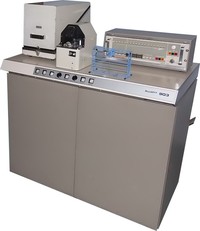Elliott 903
| Home > Browse Our Collection > Computers > Elliott > Elliott 903 |
|
The Elliott 903 was an 'inexpensive', versatile computing system for use in educational establishments, industrial research and design departments, on-line industrial and scientific applications and data processing work. It was launched in 1965 and sold for between £12,750 and £90,000 depending on the configuration. It used paper punch tape to load programs and data and was connected to a teletype terminal and paper tape punch for output. Our Elliott 903 was once owned by the British Ceramic Research Association. It was originally purchased in 1967 and was in regular use until mid 1982. The Elliott 903 was the civilian successor to the 920B computer which was installed in RAF Nimrod Mark I aircraft. It has an 18-bit processor with 8192 words of magnetic core storage. Core access time was typically six microseconds. Additional core storage could be added in blocks of 8 kilowords, up to a maximum of 64 kilowords. The 903 is physically large: it came installed in a standard-sized desk unit. The left side of the desk contains the power supply (the main logic circuits run on +/- six volts; other voltages are required by the various peripherals). The right side of the cabinet houses the processor cards and core storage. There are no microchips in the 903: logic gates are implemented on small daughterboards using a resistor-transistor logic (RTL). The top of the desk is where the paper tape punch, paper tape reader, and control unit sit. Field engineers could also attach a diagnostic display showing the status of various internal registers, as well as a 'marginal test unit'. Interactive input/output was normally handled by an attached teletype machine (not shown here). Kindly donated by Terry Froggatt.
Manufacturer: Elliott Comment on This Page Elliott 903 Manuals:
Magazines RELATED to Elliott 903 in our Library
This exhibit has a reference ID of CH32480. Please quote this reference ID in any communication with the Centre for Computing History. |
Click on the Image(s) For Detail
|











